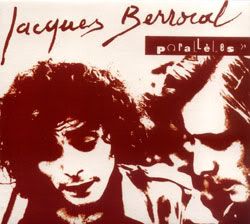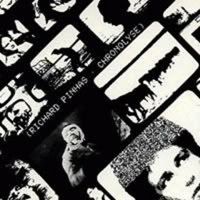
d'Avantage, 1977; reissued by Alga Marghen; available
Alga Marghen edition: 10 tracks, 61:14
Jacques (he wasn't Jac just yet!) Berrocal has been reviewed here before. This, his second album, is probably the single best-known thing he ever did. The reason for that is the avant classic "Rock'n'Roll Station", which Nurse With Wound later covered*. Here, it is scored for the powerful voice of Vince Taylor, Roger Ferlet's repetitive double bass, and Berrocal's bicycle improvisation(!). It's admittedly a great track, but it almost pales in comparison to the others. "Parallèles" itself is an improvisation by Berrocal and Ferlet, who trade off runs on valve trombone and regular trombone respectively for eight and a half minutes. Similarly, "Galimatias" is three minutes of Berrocal on solo cornet. It says a lot about Berrocal that these two tracks are endlessly fascinating despite their limited instrumentation. By contrast, "Post-card" has trombonist Berrocal and pocket trumpeter Ferlet accompanied by Michel Potage on guitar and voice. What's unusual is that this was recorded in a pigsty (yes, you can hear the pigs), and Potage recites the back of a random postcard. These four tracks made up the original A-side. "Bric-à-Brac" takes the honors of occupying the B-side, and it's a doozy for sure! In addition to Berrocal, Ferlet, and Potage (who play about fourteen instruments between the three of them), five other players are involved: cellist Philippe Pochan, double bassist Pierre Bastien, pianist Richard Marachin, and multi-instrumentalists Claude Bernard and Bernard Vitet**. True to its name, "Bric-à-Brac" is an epic noisy improvisation, never sitting in one place yet never really overdoing it either. It's subtitled "To Russolo", and that should tell you everything you need to know about how it sounds. Towards the end of the track, a version of "Rock'n'Roll Station" shows up. The album proper finishes on this delightfully unexpected note, but Alga Marghen has generously added five bonus tracks spanning '72 to '79. These range from the sound collage of "Villa Povera Naturale" to the electronic experimentations of "Cryptea IV" and "Lisylis Pavillion". The best, however, is "Occupé", a six minute gem from an unreleased Michel Potage LP featuring most of the players from "Bric-à-Brac". While this is a varied and unusual album, it's definitely a great representation of several sides of Berrocal. It's also my absolute favorite Berrocal album.
*Berrocal and Stapleton have worked together many times, going back to the second NWW album.
**Vitet, you may recall, was in the excellent Un Drame Musical Instantané.
***You may recall her from Jean Guérin's TACET; she also appears on Vitet's LA GUÊPE.


